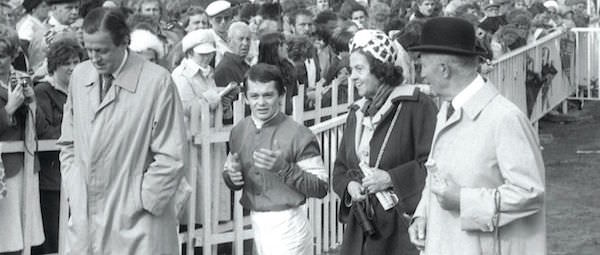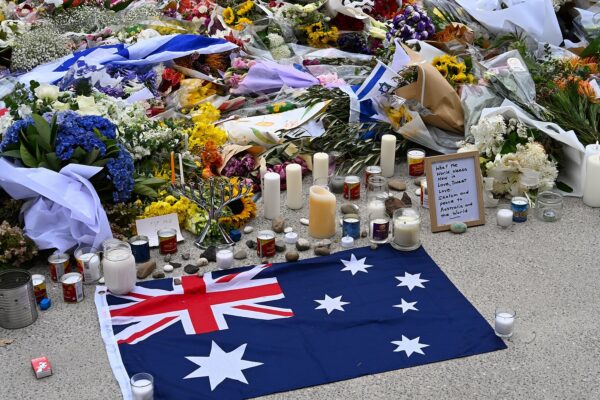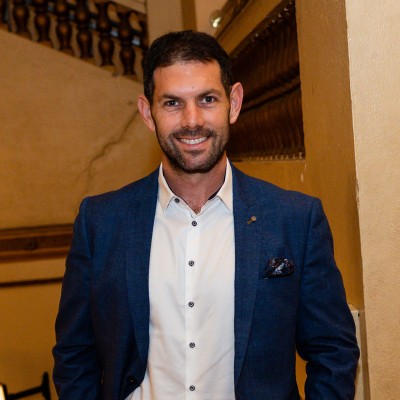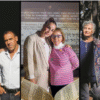
Countess Margit Batthyany in Hamburg in the 1960s. Credit: Agencja Fotograficzna Caro / Ala
Haaretz – One morning in April 2007 journalist Sacha Batthyany was approached by an elderly colleague at the Swiss daily where they both worked at the time.
The colleague waved a newspaper clipping in front of him. It was an investigative report entitled, “The Hostess from Hell,” published by a German daily.
Glancing at the headline, Batthyany didn’t understand why he was being shown this article, but then he looked at the picture of the hostess and recognized it immediately. It was Margit, his father’s aunt —someone to whom the family demonstrated the utmost respect and also around whom they tended to tread carefully.
So he started to read the piece. In March 1945, it said, just before the end of World War II, Margit held a large party in the town of Rechnitz on the Austrian-Hungarian border to fete her Nazi friends. She, the daughter and heiress of European baron and tycoon Heinrich Thyssen, and her friends drank and danced the night away.
At the height of the evening, just for fun, 12 of the guests boarded trucks or walked to a nearby field, where 180 Jewish slave laborers who had been building fortifications were assembled. They had already been forced to dig a large pit, strip, and get down on their knees. The guests took turns shooting them to death before returning to the party. The organizer of this operation was Margit’s lover Hans Joachim Oldenberg. Margit’s husband, Count Ivan Batthyany, Sacha’s grandfather’s brother, was also at the party.
It was the first time that Batthyany, then 34, had heard about this incident. He was shocked. “Let’s set aside that it was my aunt,” said Batthyany, who visited Israel last week as a guest of the Jerusalem Book Fair. “It’s just an incredible, brutal story of this night. I mean, I know there are hundreds and thousands of other [violent stories] from the war — I don’t want to compare, but if you read what happened that night it is just unbelievable.”
In the article in Frankfurter Allgemeine Zeitung, the writer, David Litchfield, describes the party as a celebration of death. Killing for dessert. “I was in shock. I was shocked and surprised that I had never heard of this. And I had studied history, I knew more than the average person, but I’d never heard about this massacre or about Rechnitz, or about my family’s connection to any kind of story connected to the Holocaust.
“I remember that I had to finish a stupid assignment I was working on but all I was thinking was that I couldn’t wait to talk to my father.
“This area between Budapest and Vienna is where my family comes from, where my family owned land and castles and stuff. I remember asking him, ‘Did you ever hear of Rechnitz?’ And he said, ‘Yes, of course.’ Then I asked him, ‘Did you know about the massacre?’ and he said, ‘Yeah, yeah. I knew about it. I heard about it, of course, I’m not stupid.’ So I asked, ‘Did you know that Margit was at the party that night when it happened?’ And he replied, ‘Yes, everyone knew it.’
“So I wasn’t talking as logically as I am now, but I said more or less, ‘So you knew A and you knew B, but you never made the connection?’ And he said no. I asked him why not and he said, ‘I don’t know why not.’
“And it was this moment that was the starting point of all the emotional stuff about not drawing the connection. Why not? Who has the power to decide not to ask? He said he never thought about it. He never thought there was a connection between the people in the castle and what happened there. Everyone knew that [Margit] had affairs with Nazis, she was a German who was very much into the Nazi regime and she had affairs, but no one ever wanted to ask the questions.”
Personal upheaval
These questions led to the appearance a decade later of “A Crime in the Family,” the fascinating book that Batthyany wrote about the incident, originally in German, and translated into English by Anthea Bell. Batthyany set out that morning in April 2007 on an in-depth search.

Sacha Batthyany and his father on a trip to Siberia. Courtesy Sacha Batthyany
With the caution of a sapper dismantling a bomb, he peeled away the historical details he needed to expose. The fact that he was asking questions of his aristocratic family, the fact that he was uncovering the layers of this embarrassing history demanded a great deal of courage. It was also a personal upheaval: How was he connected to this history? How had it shaped his life, his personality, and his image?
Everything is integrated in the book from several points of view. It’s not just the story of that sickening night. Batthyany also explores the connection between his grandmother, Marita, and an Argentinean woman named Agnes Mandel, a Jewish refugee from the village in which the two grew up, one as the daughter of the local nobleman and the other as the daughter of village Jews who were murdered.
He also tells the story of his grandfather, who was imprisoned for a decade in Siberia and came out a shadow of a man; of how his paternal grandparents fled with his father, then a teenager, from Soviet-occupied Hungary to the home of the wealthy Countess Margit. And he examines the family pathology, the pathology of men who were eternally grateful to Margit and who preferred never to ask any questions.
The Batthyanys were European aristocrats who lost most of their property under the Soviet occupation but who had obviously been important. Batthyany says that when he visited Hungary, his name jolted the hotel staff, who treated him with great respect and sent champagne and fruit to his room.
Growing up in Switzerland he was regarded as the slightly strange son of immigrants (“I have a difficult name and people thought I was from India”) and had no clue that somewhere there were streets, castles, parks and even a chocolate cake bearing the family’s name. He also had no knowledge of the dozens of Batthyany descendants who held periodic family gatherings in Austria or Hungary.
But what Batthyany saw in that German newspaper report changed everything. He responded like a journalist, getting his editor to agree to give him time off to investigate. He began reading and searching in archives and also began to question distant relatives whom he had never met. When some of the cousins told him about a family gathering that was to take place, he announced that he was coming and that he planned to discuss the story.
In his book he describes the meeting: A few dozen Batthyanys, eating sandwiches and drinking coffee from elegant cups, none of them too thrilled to discuss the matter. “After a while it became really nasty,” he says. “One of the old uncles said, ‘What if it’s all not true’ and ‘Who owns the media’ and about vested interests and all this anti-Semitic stuff. Elfriede Jelinek, an Austrian playwright, wrote a play about the story, and they were talking about her and it became nasty.”

The cover of Sacha Batthyany’s book, ‘A crime in the Family.’
Like a Mafia movie
He recalls that the deeper he dug, the more intense the reactions became, to the point that relatives warned him to stop. “They called me like in a Mafia movie – no joke, anonymous calls saying ‘your name doesn’t matter, I’m just telling you to stop.’” At that family gathering an uncle of his with whom he’d actually been quite close said, ‘Don’t play with the name of our family. You have no idea what could happen.’”
But Batthyany continued his search, travelling to Rechnitz three times, the first time as a tourist. “Then I talked to the mayor; the mayor was nice. I even spoke to a woman who was at the party that night, who has since died. She told me that not only was my aunt there, but also her husband, Ivan, who is directly my family. My father and Ivan were friendly.
“It took months. I was working at a magazine then and my boss at the time allowed me to focus on this, but after some weeks I realized that this was going to be different than any other investigative piece I’d done.”
Batthyany’s initial research resulted in a magazine feature, but the topic gave him no rest. Though it was only one night in the history of a family that ostensibly felt distant enough from the event to be able to suppress it, Batthyany was tormented. He continued to work, married and had a family. Today he and his wife and three children live in Washington, where he is a correspondent for the Germany daily Süddeutsche Zeitung and other publications. But what he thought would end with a magazine article continued to haunt him.
When the Soviets occupied Hungary, tens of thousands of people, including his father and grandfather, fled. But unlike others, who ended up in a Red Cross refugee camp, their journey ended when the rich aunt sent a private chauffeur to pick them up and bring them to a castle near the Italian-Swiss border. Their first meal was an elegant dinner with glasses of sherry.
Aunt Margit employed Batthyany’s grandfather in one of her factories, completely financed his father’s education and, as he later understood, was the dominant matriarchal figure in the family.
“I couldn’t let it go,” he says. “I knew what I had to know, but I wasn’t done. I understood that this was my family and the questions didn’t stop. The title of the book in German is exactly the question that intrigued me then: ‘What Does it Have to do With Me?’ I realized this was the question I was interested in, but I had no idea how to approach it and answer.”

Schloss Rechnitz, around 1930. Credit: Wikipedia
The answer he found was complex. Batthyany started to see a psychoanalyst, and the insights he derived from the conversations with him appear in the book. There are also sections of a diary his grandmother wrote and diligently edited in the last years of her life. The grandmother talks about the Mandels, the parents of Agnes who ended up in Argentina. Batthyany found Agnes and her daughters and formed a close relationship with them based on a shared fate and shared insights.
He also traveled with his family to Siberia to trace his grandfather’s life in the gulag and to understand what happened to him during that decade no one ever spoke about.
The picture that emerges from the book is well-rounded, moving from the personal to the historic, as it emerges that the victim and the criminal are part of the same family. Batthyany’s obsession with the past, with what happened and who was involved, seems at times like a mirror image of what so preoccupies Israelis, a desire to dig deeply and to decipher the present through people who are long lost.
Batthyany writes on the last page of the book about the similarity between him and the children and grandchildren of Agnes, again like a mirror image. He says that Agnes and the daughters and even the children of the daughters “always went to Hungary to this little tiny village in the middle of nowhere.”
He recalls: “There’s really nothing there. And they always went there to – I don’t know, to look for something or just to be there, and it was always surprising to me that even the generation afterwards, is still kind of haunted and interested in their roots.”
He says that while he studied history and psychology in university, even as a journalist he never, or hardly ever did stories on Hungary or World War II. “Before [2007] I wasn’t that interested in my family’s history. I knew just that the name is a very important name in Hungary.
“It was out of the blue,” he says that he became interested, “and I really think it probably has to do with my character,” he reflects.
“But I think [the lack of interest in history] also has to do with Switzerland. I really do think that Switzerland, although it’s in the midst of everything, is some kind of historic vacuum. There’s nothing that makes it think about what happened. There are no monuments, for example. When you’re in Hungary, even the tiniest village has three, four, five monuments in the center of the village. For example, one is for the victims of the Holocaust, the other is for the victims of Stalin’s gulags, and they are still fighting about which one is higher. That’s Hungary.
“So the only thing connected to all of these things and all these dark chapters of our history is in school, when you have your teacher – but it’s all in theory, not something you share on an emotional level.”
He says most Swiss children do not ask their parents and grandparents what they did during the war. “You don’t ask because there wasn’t much,” he says. Basically, he observes, life in Switzerland doesn’t demand any confrontation with your past, or any past at all.
He recalls that his first readers were friends or journalists from Switzerland. While they liked his writing, they would also write things like ‘I don’t really understand this thing with the past,’ he says. In Switzerland, this connection with the past is considered odd, he says.
“I think I’m a bit jealous.”
Batthyany laughs and says: “I was scared because I thought I shouldn’t have done it.
“But then the book was received entirely differently in Hungary, Germany and Austria [than in Switzerland]. You always carry the past with you, it’s what you are. There are those who don’t want to be aware, but if you feel the burden of the past you will see the connection to the present, to who you are.”
Originally Published HERE By Gili Izikovich







